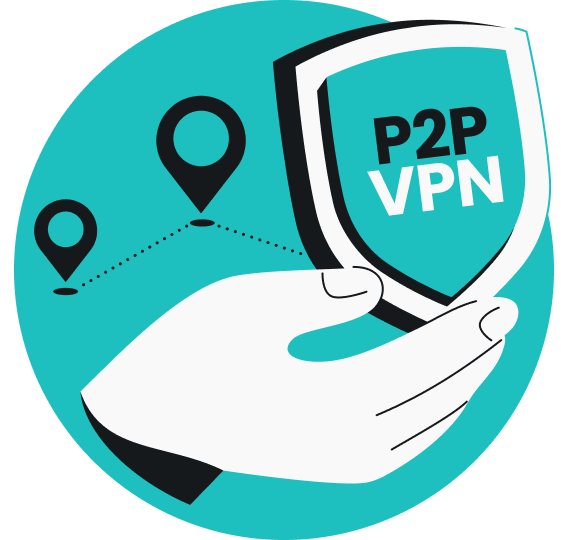
If you’re reading this, you probably already know what a VPN is — maybe you’re even using one right now. But have you ever wondered where VPNs came from or how they became so popular? Well, they didn’t just appear overnight — they’re the result of decades of innovation in computer networking. The history of VPNs is filled with technological breakthroughs, increasing threats, and a growing need for online privacy and security.
Table of contents
The beginnings of networked computing (1960s – 1970s)
It’s hard to talk about VPNs without explaining how the internet began. Each stage of its development brought new challenges, which VPNs have evolved to address. Let’s take a trip back in time to see how it all started.
The birth of ARPANET
In the 1960s, the US Department of Defense worked on a project called the ARPANET, a network that allowed computers to talk to each other over long distances. It may not sound like much now, but the idea was groundbreaking at the time. ARPANET used packet switching, which meant the data was broken up into small pieces (or packets) before being sent across the network to its destination. This idea laid the foundation for what would eventually become the internet.
The development of TCP/IP
It wasn’t until the 1970s, however, that the development of TCP/IP (Transmission Control Protocol/Internet Protocol) brought everything together. TCP/IP enabled different networks to communicate with each other, growing the internet from a handful of connected systems to the global web we know today. TCP/IP is still the internet’s backbone, and its invention ultimately set the stage for secure, remote communications that would later be adopted by VPNs as well.
Laying the groundwork for VPNs (1980s – 1990s)
As the internet grew in the 1980s and 1990s, people began sharing more and more information online. But with this growth came new concerns: how do we keep that information safe? Can we be sure that no one can intercept it? The internet needed encryption methods to protect data as it traveled across the network and needed them fast.
The rise of secure communication
One of the first attempts to secure data occurred in the 1980s when the Software IP Encryption Protocol (swIPe) was developed. The idea was simple: ensure that data could only be read by the people it was intended for. Although swIPe was an experimental protocol, it was an important early step toward creating the kind of secure tunnels that VPNs use today.
The introduction of IPsec
The real game-changer came in the mid-1990s with the introduction of IPsec (Internet Protocol Security). IPsec provided a way to encrypt and authenticate data at the IP level, the elementary communication language of the internet. While IPsec wasn’t a VPN by itself, it became a crucial part of many VPN solutions. It was widely used by most VPN services until recently when more efficient protocols such as OpenVPN and WireGuard finally took over.
The first VPN protocols (Mid-1990s)
By the mid-1990s, the internet was expanding rapidly, and the need for secure connections became even more urgent. This is when VPN technology, as we know it, began to take shape.
The first VPN protocols, PPTP and L2TP
In the mid-90s, Microsoft developed the Point-to-Point Tunneling Protocol (PPTP). This protocol allowed users to establish secure connections over the internet, which was revolutionary for anyone needing privacy. PPTP was not without its limitations, however, especially when it came to encryption.
Around the same time, Cisco introduced another tunneling protocol called Layer 2 Forwarding (L2F). And while it improved on some aspects of PPTP, it wasn’t perfect either. Realizing the limitations of these early protocols, Microsoft and Cisco joined forces to develop the Layer 2 Tunneling Protocol (L2TP).
L2TP combined the best features of both PPTP and L2F, offering a more secure and flexible solution for creating VPNs. Although some VPN services still use it today, they’re better to avoid since L2TP can’t offer the security or reliability of OpenVPN, IKEv2, or WireGuard.
VPNs for business (early 2000s)
As the internet became more integral to business operations in the early 2000s, VPNs evolved from niche tools into essential components of modern business strategy. Let’s see how the VPN market responded to skyrocketing security needs.
The internet becomes essential for business
In the early 2000s, companies started to build their entire infrastructure online, from internal communication systems to customer-facing services. Unsurprisingly, hackers and cybercriminals responded to this growth by trying to abuse these systems, leading to a pressing need for better security measures.
The evolution of enterprise VPNs
During this time, VPNs evolved into a vital tool for businesses. Initially, they were used by large organizations to connect remote workers or different office locations securely and protect sensitive information from prying eyes. Over time, VPNs became an essential part of IT security strategies, offering businesses a reliable way to safeguard their operations.
VPNs for the masses: empowering individual privacy (Mid-2000s)
It didn’t take long for VPNs to become popular with everyday internet users. By the mid-2000s, the internet was playing a bigger role in everyone’s lives — and so did the risks associated with being online.
The rise of cybercrime
As people began using the internet for everything from banking to shopping, cybercriminals saw an opportunity. Phishing scams, malware, and other online threats have become commonplace. For many users, these risks were eye-opening — they realized that personal information must be protected just as much as business operations. This growing awareness of online threats led to a surge in demand for security and privacy tools.
The emergence of consumer VPNs
Enter consumer VPNs. In the mid-2000s, companies began offering VPN services designed specifically for individuals. These services were easier to use and more affordable than the enterprise-grade VPNs that came before them. Suddenly, anyone could use a VPN to protect their online activities, whether they wanted to secure their connection on public Wi-Fi, avoid surveillance, or circumvent geo-restrictions. This was a major turning point — VPNs were no longer just for techies or big corporations; they were now for everyone.
Evolving VPN technology and features (2010s)
In the 2010s, VPN technology continued to evolve to keep pace with the growing complexity of online threats. VPNs became faster, more secure, and easier to use.
Advancements in VPN protocols
In the 2010s, new VPN protocols were developed to improve speed, stability, and security. For example, IKEv2/IPsec became popular for its ability to maintain a stable connection even when switching between networks, such as when moving from Wi-Fi to cellular data.
Another protocol, Secure Socket Tunneling Protocol (SSTP), provided a high level of security, especially for Windows users, by using the same encryption technology that protects HTTPS websites.
These advancements made VPNs more reliable and accessible, allowing more people to enjoy secure and private internet access without compromising speed.
Addressing the challenges of cloud computing
As more businesses moved to the cloud, traditional VPNs faced new challenges. The hub-and-spoke model used by many remote-access VPNs could cause latency when accessing cloud-based applications, resulting in slower performance.
To address this, new solutions like Software-Defined WAN (SD-WAN) and Secure Access Service Edge (SASE) emerged. These technologies provided more streamlined and secure ways for businesses to connect to the cloud, ensuring that VPNs remained relevant in a rapidly changing digital landscape.
Enhanced privacy features
Another priority for VPN providers in the 2010s was privacy. No-logs policies, which ensure that VPN services don’t keep records of users’ online activity, became standard. Features like the kill switch, designed to automatically disconnect the internet if the VPN connection goes down, and double VPN, which routes traffic through multiple servers for added security, were also introduced.
These developments not only made VPNs more secure but also more appealing and user-friendly.
VPNs in the COVID-19 era: adapting to a remote world (2020s)
The COVID-19 pandemic changed the way we live and work almost overnight. With millions of people suddenly working from home, the need for secure internet connections has become more critical than ever. VPNs played a critical role in this new reality, helping businesses and individuals stay connected and protected.
The shift to remote work
When the pandemic hit, companies around the world had to quickly figure out how to keep their operations running with a fully remote workforce. This meant finding a way for employees to securely access company networks from home. Understandably, VPNs were the go-to solution. They provided secure, encrypted tunnels for data, ensuring that sensitive information remained protected even over public internet connections.
This also reflects in the statistical interest in VPNs, with a noticeable rise beginning in 2020, at the start of the pandemic.
However, the sudden surge in VPN usage exposed some limitations. Traditional VPN infrastructures weren’t always ready to handle the massive increase in users, leading to performance issues and the need for rapid scaling.
Innovations in VPN technology
In response to these new challenges, VPN providers adapted quickly. Many scaled up their infrastructure to handle more users, while others introduced new features to make remote work easier and more secure. For example, split tunneling became more valuable, allowing users to route some of their traffic through the VPN (for work) while sending other traffic directly to the internet (for personal tasks). Multi-factor authentication (MFA) was also integrated into many VPNs, adding an extra layer of security to prevent unauthorized access.
These innovations ensured that VPNs could meet the demands of a remote workforce, helping businesses stay secure during one of the most challenging periods in recent history.
The future of VPNs: decentralization, AI, and beyond
As we look to the future, it’s clear that VPNs will continue to evolve to meet the challenges of our increasingly online world. From new technologies like decentralized VPNs (dVPNs) to the integration of artificial intelligence (AI), the next generation of VPNs is set to be even more powerful and versatile. Let’s explore what’s on the horizon.
The rise of decentralized VPNs
One of the most exciting developments in VPN technology is the rise of decentralized VPNs. Unlike traditional VPNs, which rely on a centralized server network, dVPNs connect to peers to route your internet traffic. This decentralized approach offers greater privacy and resistance to censorship, making it harder for any single entity to control or block your connection. As concerns about internet censorship and surveillance grow, dVPNs could become a popular choice for users seeking more control over their online privacy.
The role of AI in VPN technology
Artificial Intelligence is also set to play a significant role in the future of VPNs. AI could automatically detect and respond to threats faster than traditional methods, making your connection more secure. For example, it could adjust encryption settings based on the level of risk or optimize server selection to give you the fastest possible connection. As online threats become more sophisticated, AI-powered VPNs will help keep you one step ahead.
VPNs and the Internet of Things (IoT)
The Internet of Things (IoT) is rapidly expanding, with more and more devices becoming connected to the internet. From smart home gadgets to wearable tech, these devices often lack robust security features, making them vulnerable to attacks. VPNs will play a crucial role in securing these connections, ensuring that your personal data remains safe no matter what device you’re using. As IoT continues to grow, so too will the importance of VPNs in protecting your online life.
Securing the future: why online security matters
As we’ve explored the history and evolution of VPNs, one thing is clear: online security is more important than ever. The internet has transformed our lives in countless ways, but it has also exposed us to new risks. Your online activity can be tracked, monitored, and even exploited if you’re not careful.
This is where Surfshark comes in. At Surfshark, we believe that everyone deserves the right to privacy and security online. Our VPN empowers you to take control of your digital life simply by offering you peace of mind. With features like a no-logs policy, Kill Switch, and Dynamic MultiHop, Surfshark ensures your data stays protected no matter where or what you’re doing online.
FAQ
When were VPNs invented?
VPN technology began to take shape in the mid-1990s, with the development of the first VPN protocols like PPTP by Microsoft in 1996. However, the foundational technologies, such as IPsec, were introduced earlier in the decade.
Does a VPN hide browsing history?
Yes, a VPN hides your browsing history from your internet service provider (ISP) and other third parties by encrypting your internet traffic. However, your browser may still store some data locally, like cookies and cached files.
Who is the founder of VPN?
There is no single “founder” of VPNs, as they evolved from various technologies developed by multiple companies and researchers. However, Microsoft played a significant role in creating the first widely used VPN protocol, PPTP, in the mid-1990s.
Why did VPNs become popular?
VPNs gained popularity as online privacy concerns grew and the need for secure remote access increased, especially for businesses. The rise of cybercrime, government surveillance, and the demand for uncensored internet access also fueled their widespread use.
What is the oldest VPN?
The oldest VPN protocol still in use today is PPTP (Point-to-Point Tunneling Protocol), introduced by Microsoft in 1996. Despite its age, PPTP is considered outdated due to its weak encryption standards.


